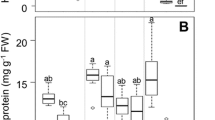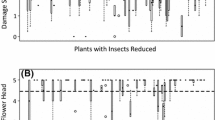Abstract.
Herbivory is an important selective pressure in the life history of most plant species, as it usually results in reduced plant fitness. In some situations, however, plants are able to compensate for the resources lost to herbivory and do not suffer any reduction in growth or reproduction after attack. We examined the ability of Lebanese cucumber (Cucumis sativus) to compensate for both pre-flowering and during-flowering foliar herbivory through increased photosynthetic efficiency and capacity. Plants that were damaged before flowering were able to compensate, in terms of vegetative biomass and fruit production for up to 80% leaf area loss. Plants that were damaged during the flowering period were less able to compensate and fruit production declined with increasing herbivory. Damaged plants had higher photosynthetic efficiency and capacity, and dissipated less light energy as heat. Herbivore-damaged plants may be induced to use a greater proportion of the absorbed light energy for photosynthesis as a result of altered carbohydrate source-sink relationships.
Similar content being viewed by others
Author information
Authors and Affiliations
Additional information
Electronic Publication
Rights and permissions
About this article
Cite this article
Thomson, V.P., Cunningham, S.A., Ball, M.C. et al. Compensation for herbivory by Cucumis sativus through increased photosynthetic capacity and efficiency. Oecologia 134, 167–175 (2003). https://doi.org/10.1007/s00442-002-1102-6
Received:
Accepted:
Issue Date:
DOI: https://doi.org/10.1007/s00442-002-1102-6




